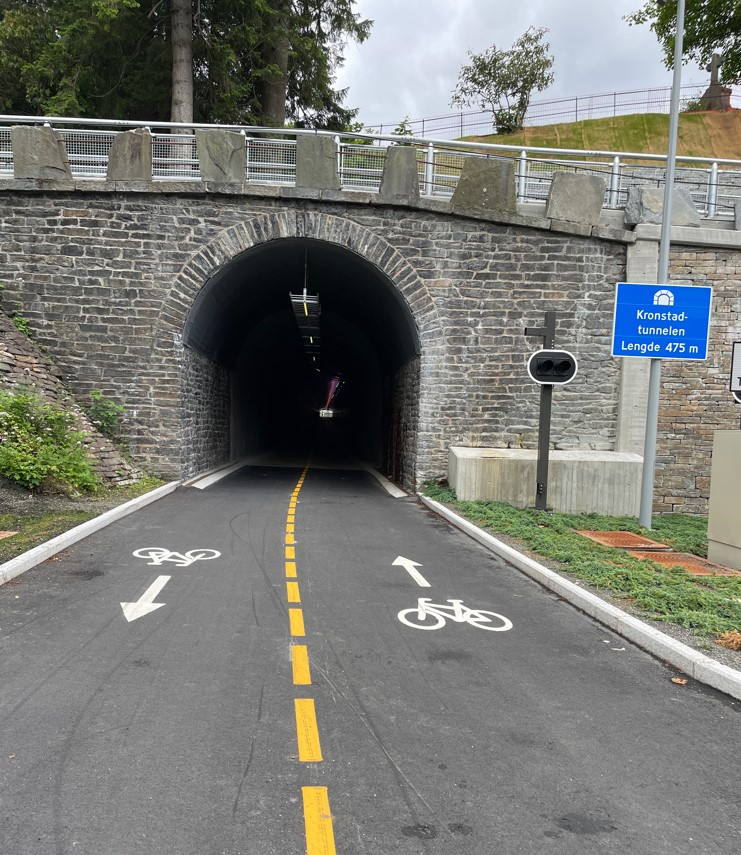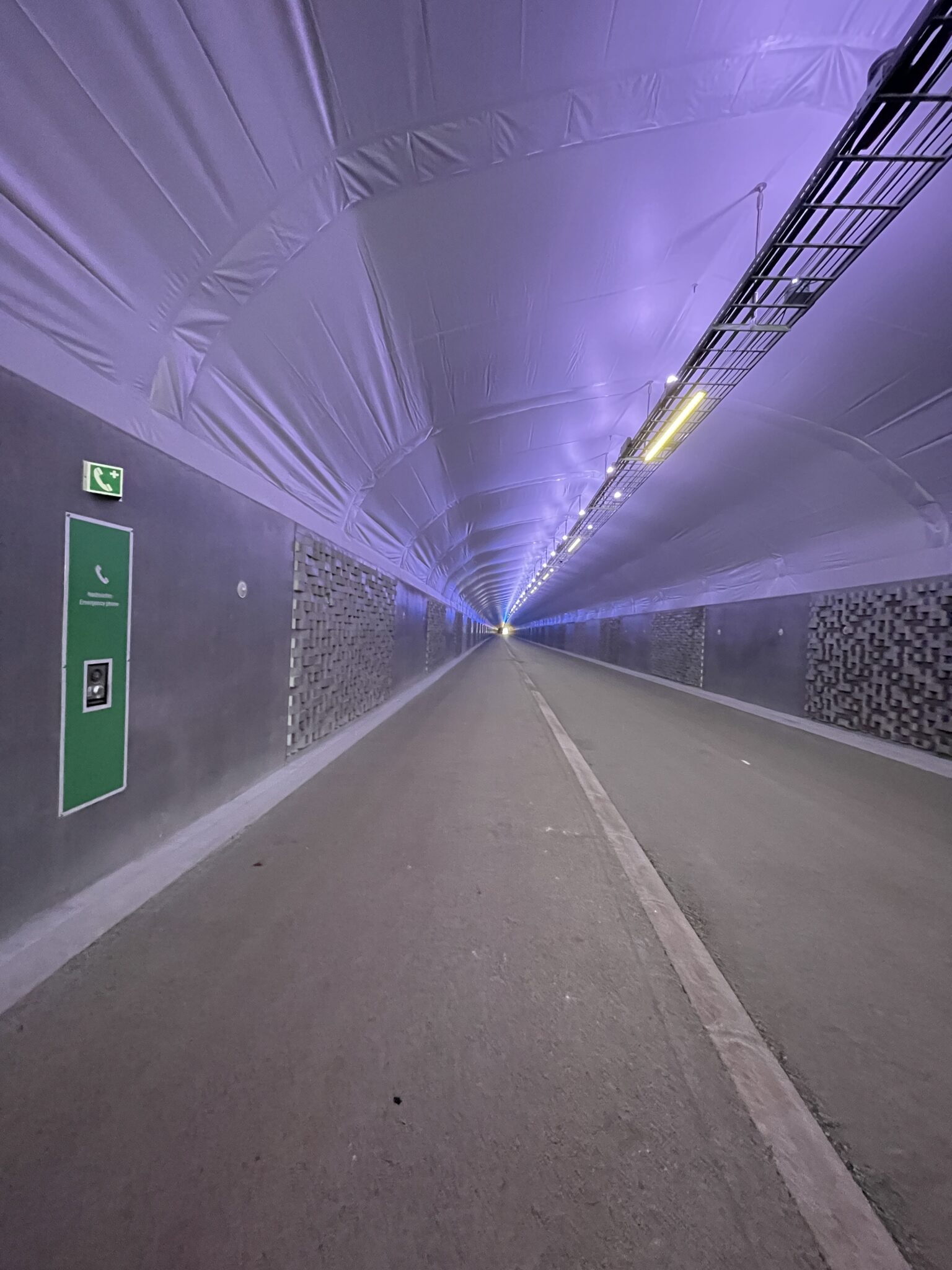Bybanen d18 Walking Cycling Tunnel - BRE Group
Bybanen walking and cycling tunnel gains BREEAM Infrastructure Excellent
Overview
The full name of this project is D18 Sykkelvei Kronstadtunnelen. It’s part of the Bybanen-light rail construction stage 4 development scheme. This is the largest development scheme in the city of Bergen, Norway. The D18 project involves building a new pedestrian and cycling path that will increase the accessibility to green transportation and significantly improve the mobility demands in Bergen.
About
Veidekke was the contractor on this project. It has been building roads in Norway since 1936 and today also works on tunnels, bridges and houses throughout Scandinavia.
Background
This new tunnel aims to provide safe and easier transportation linkages between the city centre and southern parts of the city. The goal is that the new transportation path will reduce emissions and improve air quality by reducing congestion and number of vehicles driving through the city centre.
The project-specific objectives were:
Transforming, widening and repurposing the 100-year-old, 500-meter-long Kronstad railroad tunnel, while simultaneously preserving its historic integrity. The “Kronstad tunnel” is both a soft-ground and hard rock tunnel.
Constructing a new service tunnel for the Norwegian National rail administration to make space for a new cycling path.
Renewing below-ground water and sewage-infrastructure.
Protecting the existing landscape, the Møllendal river and nearby historic assets.
Groundworks and improving surrounding infrastructure.
Deconstruction of a building and bridge.
Construction of new high standard pedestrian and cycle paths.
The construction started June 2021 and completion/opening of the new bicycling and pedestrian path was March 2023.

Challenges
One of the project key challenges was minimising the project’s impacts on sensitive, neighbouring institutions such as the cemetery and the burial ceremony facility. In addition the tunnelling works were located directly below the Haukeland hospital maternity clinic and the hospital eye-department, where activities like high-precision operations were performed. This meant works were carried out at specific times, with thorough coordination with neighbours, to minimise disruption. A dedicated neighbour contact also provided follow-ups.
Solutions
Project management
Veidekke formed its own project-level sustainability policy to commit the project team to a responsible and sustainable construction phase. The purpose of the policy was to frame the thinking and perspective of all involved in the planning and execution of the project. In addition, an environment management system was followed to manage the project's environmental and social risks, impacts and opportunities. This included the environmental management plan that contained targets, activities and measures put in place to improve the construction performance and mitigate the impacts.
An extensive collaboration between the client, designer and contractor made it possible to complete the project and improve the environmental and sustainability performance during construction.
Landscape and historic elements
All works at the construction site was carried out within existing infrastructures or paved areas. However, there are ecological features nearby that has been taken into consideration, such as vegetation along the river sides, the Møllendal river and large tress alongside the cemetery and rig area. These features were protected, monitored, and successively preserved during construction.
Mass handling on site regarding masses contaminated by injurious species have been followed according to the client's action plan. Contaminated masses are delivered to a local licenced mass facility to be treated. After treatment the masses are suitable for re-use. Areas of Japanese knotweed was identified early on, which was removed in according with the project’s invasive species plan. The soils infected with invasive species are treated with heat to kill the plants, then mixed with surcharge and re-used.
Works were in close proximity to historic assets such as a monumental burial mound, industrial building “Barkemøllen” from 1614 and an old tunnel portal. Therefore, the client documented a full heritage record before construction work started, as the impacts on the historic features are important and required actions to prevent potential damages. This included thorough ground-monitoring around the historic portal for instabilities and movements, as well as fencing in areas of concern.
The water environment
There are several actions taken to protect the nearby river called Møllendal river and to improve the water environment. These included daily visual inspections of the river, water treatment plant and water handling on site. Treatment facilities was placed to collect process water during construction. All collected water was continuously checked and measured before discharge, following the plan for water control on site. Collected water was treated and reused in the production process. No public drinking water was used for tunnelling, only treated water from the site.
Remediating contaminated ground and exchanging all masses in the tunnel to reduce the leakage of pollutants to Møllendal river.
New VA-system will lead to increased release of water into the river, causing a steadier waterflow and improved water environment in the anadrome stretch of the river.
Neighbours and communities
During the construction stage, Veidekke coordinated with the client to maintain good relations with the local community and stakeholders. There have been several ways for the community to interact, such as project website/blog, posters placed on site fences, information meetings, mail services, and the client’s communication channels. In addition, a dedicated neighbour contact was responsible for ongoing community consultation and kept the dialogue with the neighbouring residents and local businesses, such as the adjacent cemetery/burial ceremony facilities and hospitals. Before each blast a text message has been sent out to inform everyone about the ongoing tunnel works.
Resource efficiency
Other key achievements are finding optimising solutions to reduce emissions, material resources and production time. Several optimisations were suggested and implemented in cooperation with the client:
Reduced profile of the cable and pipe ditch in the Kronstad tunnel reduced the outtake of rock by 7200 m3, reducing transportation fuel consumption, as well as associated noise and traffic, saving 57,7 tons CO2e.
Improved waterproofing of a service tunnel, replacing full concrete casting of the tunnel vault with a thin membrane and shot-concrete, saving 134,6 tons CO2e.
Experimenting with new materials like foam glass to replace concrete in the escape-tunnel, saving 29,4 tons of CO2e.
The majority of concrete structures are built with low-carbon concrete, class A with emissions of < 220 kg CO2 equivalents/m3.
In addition, surplus material arising from site was returned to supplier, for instance bolt, concrete, wooden pallets and concrete objects. To prevent material abundance on site the project team members used the BIM model to order correct amounts of materials and resources and had spaces dedicated for storing.
Energy and machinery
Specific sustainability targets were put in place for the machinery on site. Veidekke committed to execute the project with the use of minimum 80% renewable energy using HVO100 certified palm-oil free biodiesel and electricity. The project achieved a renewable energy use of 84.7% during construction.
The planned project execution was based on machines running on biodiesel, but the project worked hard to move towards electrification. Four electrically powered excavators were used in the project, and towards the end almost all ground works were powered by electricity. The project also piloted an electrically powered concrete pump truck to great success. Another pilot included an electrical cabinet providing detailed monitoring of power consumption during construction, allowing for better planning regarding electrical machinery as well as increasing safety on site by preventing power outages.
Benefits
Undertaking a Breeam assessment gave the project an objective measurement of sustainability performance, benefiting both the client and contractor.
Breeam Infrastructure has led to more discussions and awareness about sustainability in the project organization. The project team created project specific sustainability targets, in addition to the company and client`s goals/targets. A live KPI board made the targets visual for everyone to follow. The focus on sustainability throughout the project led to a willingness to test new solutions that were implemented in the project.
Best practice and innovation
Two innovative construction methods relating to the electrification of construction sites and reducing carbon emission has been utilized during construction:
The smart power-cabined distributes the electricity demands on site and gives a complete picture of the consumption in real time and historical data. The technology enables the transition of replacing fossil energy and use electricity as the main energy source on construction sites.
In cooperation with the concrete supplier, the project used an electric concrete pump on site with a 42 metres arm length. The vehicle contributes positively to the environment as well as work conditions for workforce, because of no pollution and less noise. The goal was to use green electricity as energy source to work towards zero emissions of CO2.

Summary
Melissa Langnæs, Veidekke Entreprenor AS
